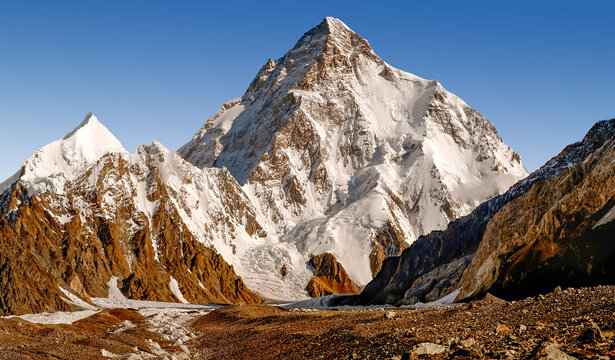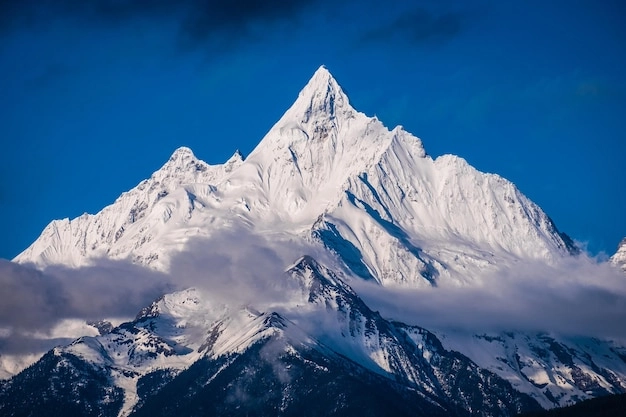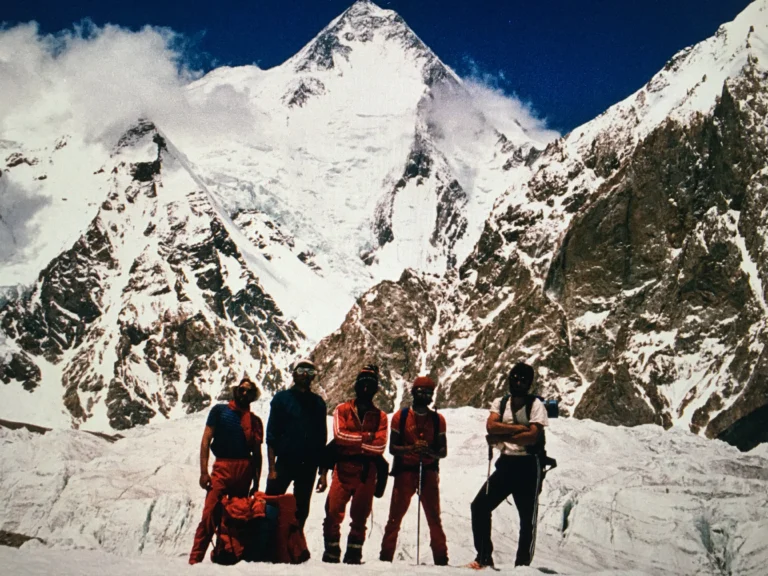Record-Breaking Climbs on K2 and the Karakoram in 2024-25
Record-breaking climbs on K2 and the Karakoram. The past two years have been extraordinary for mountaineering in Karakoram. Climbers are shattering barriers of age, speed, and style on the world’s most formidable peaks. From teenagers standing atop K2 to lightning-fast ascents and unprecedented winter triumphs, the Karakoram range is witnessing a new era of achievements. In this blog, we dive into the record-breaking climbs on K2 and the Karakoram in 2024 and 2025 – highlighting the youngest summiteers, fastest ascents, and unique summit attempts that are rewriting history. We’ll also compare these feats with past records to understand the significance of these milestones for the mountaineering community.
Record-Breaking Climbs on K2 and the Karakoram – A New Generation of Summiteers

K2, known as the “Savage Mountain,” towers above the Karakoram glaciers.
A new generation of climbers is conquering the Karakoram’s giants at ages once unimaginable. Pakistani mountaineer Shehroze Kashif made headlines by summiting Everest and K2 in 2021 at just 19 years old. Guinness World Records recognized him as the youngest person to scale the two highest mountains in the same year, and he also became the youngest ever to stand atop K2.

“I got emotional, thinking that they had come with the same passion I had… Why not fulfill their unfulfilled dream? And I took their dream with me,” Kashif said, reflecting on those who perished before his K2 climb. His youthful passion inspired others to chase 8000-meter summits while honoring past climbers.
In 2024, the bar was raised even higher – or rather, younger. Nima Rinji Sherpa of Nepal, only 18 years old, completed the astounding challenge of scaling all 14 of the world’s 8,000-meter peaks. This record-breaking climb spree included K2 (which he summited on July 27, 2023) and culminated with Shishapangma in October 2024. Nima’s achievement smashed the previous age record (held by Mingma “David” Sherpa, who was 30 when he finished all 14), proving that the next generation is capable of Himalayan feats in their teens. On the women’s side, Britain’s Adriana Brownlee had become the youngest woman to summit K2 at age 21 in 2022
– another example of youth reaching the top of Karakoram. These young climbers aren’t just collecting records; they’re bringing fresh energy and inspiration into high-altitude mountaineering.
Fastest Ascents: Speed Records Shattered
Not only are climbers getting younger, they’re also getting faster.

In July 2024, French alpinist Benjamin Vedrines sprinted up K2 in a mind-blowing 11 hours from base camp to summit. Importantly, he climbed without bottled oxygen, slicing in half the legendary no-O2 time of 23 hours set by Benoît Chamoux in 1986. “I still find it hard to believe,” Vedrines said after his blitz ascent. “When I was up there, I also had a hard time realizing where I was and how I got there”. His climb set a new fastest known time on K2 and overtook the previous speed mark of 12 hours 20 minutes achieved (with supplemental oxygen) by Chhiring Sherpa in 2022. Such record-breaking climbs on K2 and the Karakoram exemplify how modern training, optimal weather windows, and maybe a bit of luck can push the limits of human possibility on the world’s second-highest mountain.
The speed fever isn’t limited to a single peak. In 2023, Norwegian climber Kristin Harila and Nepali Tenjen (Lama) Sherpa set an outrageous 8000-meter speed record, summiting all 14 of the world’s highest mountains in just 92 days. Their final peak was K2 on July 27, 2023, after which Harila exclaimed that they had “shattered the previous record” of 189 days. While Harila’s project spanned the Himalaya and Karakoram broadly, it underscores the trend: record-breaking climbs on K2 and the Karakoram are part of a larger wave of climbers completing challenges at unprecedented speed. The boundaries set by legends like Reinhold Messner and Nirmal “Nims” Purja (who did all 14 peaks in 6 months) are being tested and often exceeded by today’s elite mountaineers.
Unique Summit Attempts and Unprecedented Feats
Beyond youth and speed, the Karakoram has seen one-of-a-kind accomplishments recently. In winter – a season long deemed impossible for K2 – a historic breakthrough occurred. On January 16, 2021, a team of 10 Nepali climbers led by Nimsdai (Nirmal) Purja and Mingma Gyalje Sherpa made the first-ever winter ascent of K2, at last conquering the only 8000m peak that remained un summited in winter.

“We set out to make the impossible possible and we are honored to be sharing this moment… to show that collaboration, teamwork and a positive mental attitude can push limits to what we feel might be possible,” Purja said from the summit. This triumph – in winds of over 100 km/h and temperatures of -60°C – marked a unique record in mountaineering history and demonstrated unparalleled teamwork in brutally cold conditions.
Climbers are also finding creative ways to link summits or descend. Vedrines had even planned to paraglide from K2’s summit after his speed climb – a daring idea that illustrates the innovative spirit in today’s expeditions (though it remains unconfirmed if he flew down). In 2018, Polish skier Andrzej Bargiel famously became the first to ski down from K2’s summit, another feat once thought unthinkable. And while that was a few years earlier, it set the stage for climbers attempting unique summit approaches and departures in the Karakoram.
Meanwhile, full expedition teams are achieving what used to be rare. In summer 2024, Nepal’s 8K Expeditions reported a 100% success rate on K2 – their entire international team of clients and Sherpa guides stood on the summit on July 28. Such an outcome reflects the improved logistics, route fixing, and guiding expertise now present on K2. The once-unclimbable “Savage Mountain” is seeing commercially guided teams pull off record-breaking climbs with everyone reaching the top, a scenario unimaginable in the past.
It’s worth noting that climbers are still seeking new challenges on these peaks. In 2023, two elite Japanese alpinists attempted a bold new route on K2’s unclimbed West Face in pure alpine style (no fixed ropes or support). This was an extremely rare approach – the West Face had only been successfully climbed once before, in 2007. Tragically, the pair fell to their deaths high on the face, highlighting that the Karakoram’s dangers are ever-present. Their attempt, although unsuccessful, exemplifies the relentless human spirit to explore new ground. Whether it’s pioneering routes or setting speed and age records, the Karakoram continues to be the ultimate arena for mountaineering creativity and courage.
Women Making History in the Karakoram
The recent surge of record-breaking climbs on K2 and the Karakoram includes groundbreaking achievements by women climbers, who are reaching new heights and smashing glass ceilings. In July 2022, Samina Baig of Pakistan became the first Pakistani woman to summit K2, planting her country’s flag atop the 8,611-meter peak. She was joined that day by climbers from Iran and other nations, marking a record number of female summits in a single push.

By the summer of 2023, more women than ever were climbing K2 – a record 20 women reached the summit that season, a reflection of growing female participation in high-altitude climbing. Among them was Naila Kiani from Pakistan, who not only summited K2 but also became the first Pakistani woman to scale neighboring Nanga Parbat (8126 m) in 2023. Meanwhile, climbers like Grace Tseng of Taiwan made news for summiting K2 without supplemental oxygen in 2022
, and He Jing of China did the same, showing that women are not just climbing these peaks but doing so in bold style
. The increased presence and success of women in the Karakoram is a milestone in itself – a far cry from past decades when the world’s highest peaks were almost exclusively trodden by men. It adds another layer to the significance of recent climbs, proving that mountaineering’s future will be more inclusive and diverse at the top of the world.
Rewriting History: Why These Records Matter
The flurry of record-breaking climbs on K2 and the Karakoram in 2024 and 2025 is more than just a collection of trivia – it signifies a fundamental shift in what humans can achieve in extreme altitude. Comparing today’s milestones with past records highlights how far we’ve come. Consider that in 1986, only a handful of climbers managed to summit K2, and Chamoux’s 23-hour ascent without oxygen was almost mythical. Fast forward to recent years: in a single day in July 2022, 145 people reached K2’s summit – more than had summited the mountain in the first 50 years of its climbing history. The entire 2022 season saw 200 K2 summits, dwarfing the previous record of 62 in 2018. By August 2023, an estimated 800 people in total had summited K2 (with roughly 96 fatalities over the years). These numbers show a dramatic change in accessibility: what was once the prized feat of an elite few has become a goal attainable by many well-supported climbers.
Why does this matter? Firstly, it reflects advancements in gear, weather forecasting, and high-altitude logistics. Sherpa guides and collaborative expeditions have made peaks like K2 safer and more attainable than before – though still perilous. The tragic death of a Pakistani high-altitude porter in 2023 near the summit reminds us that these achievements come with risks and ethical challenges. The drive for records raised discussions about climbing ethics, especially when videos emerged of climbers continuing to the top while a stricken teammate was in need. Such incidents prompt important conversations about responsibility and humanity on the mountain, even amid record pursuits.
On a more inspirational note, these records ignite the imagination of the global climbing community. Seeing an 18-year-old finish all 8000ers or a team finally crack the code of K2 in winter expands our sense of what’s possible. Each record broken on K2 or its Karakoram sister peaks is a nod to all the climbers who came before – those who first ascended in 1954, the pioneers who tried new routes, the ones who pushed the limits of speed and endurance. Today’s climbers stand on their shoulders, often literally following their routes, but now achieving feats in days or even hours that once took months or years.
In conclusion, the recent record-breaking climbs on K2 and the Karakoram have ushered in a thrilling chapter in mountaineering. They combine youthful ambition, refined skill, and the hard lessons of past expeditions. For readers and enthusiasts of high-altitude climbing, these stories are both informative and exhilarating – proof that the spirit of exploration is alive and well at the roof of the world. As new records are set and old ones fall, one thing is certain: the Karakoram will continue to test the limits of human potential, and the world will be watching with bated breath as climbers write the next page of mountaineering history.
FAQs:
- What is the latest breaking news on K2 and the Karakoram in 2024-25?
Climbers have achieved record-breaking ascents on K2 and other Karakoram peaks. - Who set new records on K2 in 2024-25?
Top mountaineers have shattered previous climbing records on K2 this season. - What challenges did climbers face on K2 in 2024-25?
Extreme weather, avalanches, and altitude sickness tested climbers’ limits. - How has climbing technology evolved in Karakoram?
Advanced gear and better forecasting have improved summit success rates.
5. Where can I follow live updates on K2 climbs?
Check mountaineering news sources and official expedition reports.






